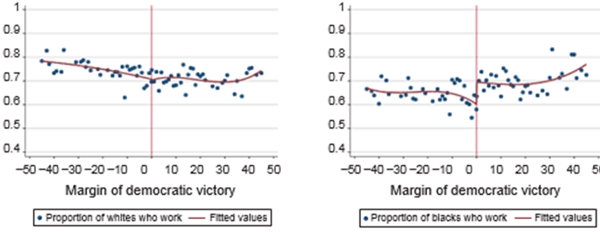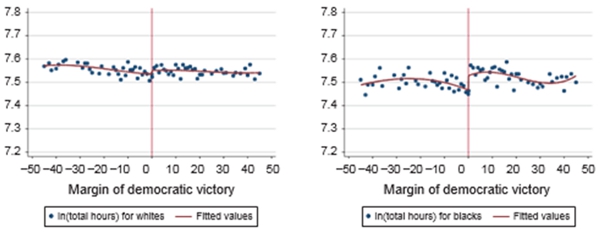 In recent years, inequality has come to the forefront as a political concern. In new research, Louis-Philippe Beland examines how the party affiliation of state governors affects the earnings gap between black and white workers. Using labor market and election data, he finds that under Democratic governors, blacks are more likely to participate in the labor market and work more intensively, narrowing the earnings gap between blacks and whites.
In recent years, inequality has come to the forefront as a political concern. In new research, Louis-Philippe Beland examines how the party affiliation of state governors affects the earnings gap between black and white workers. Using labor market and election data, he finds that under Democratic governors, blacks are more likely to participate in the labor market and work more intensively, narrowing the earnings gap between blacks and whites.
Politicians and political parties play a crucial role in the US economy. The common perception is that Democrats favor pro-labor policies and are more averse to income inequality than Republicans. In recent research, I evaluate the impact of political party affiliation of governors (Republican versus Democratic) by looking at the following labor market outcomes: hours worked, weeks worked, employment, labor-force participation, and earnings. Given that there is an important and well-documented earnings gap between black and white workers, I investigate whether the party affiliation of governors affects this gap. This is an important issue given that a large proportion of black workers vote for Democrats.
I find that under Democratic governors, blacks are more likely to work, participate in the labor market, and work more intensively. This leads to an increase in the annual hours worked by blacks relative to whites, which decreases the earnings gap between blacks and whites.
To investigate the impact of political parties on the labor market, I match data from the Current Population Survey’s (CPS’s) March supplements from 1977 to 2008 with gubernatorial election data from the University of Michigan and the Atlas of US Presidential Elections. Variables of interest taken from these sources are the party of the winner and the margin of victory. Only elections where either a Democrat or a Republican won were included.
My empirical strategy relies on the randomness associated with close elections and compare labor-market outcomes when a Democrat barely wins an election to labor-market outcomes when a Democrat barely loses. This allows us to evaluate the causal impact of the political party in power on the labor market. This methodology is used in several papers and relies on the work of David Lee.
Figure 1 and 2 below show the discontinuity when a Democrat barely wins over a Republican. They suggest that there is a higher proportion of blacks who work under Democratic governors and that they work more hours.
Figure 1 – Margin of Democratic victory and the proportion of whites (left) and blacks (right) who work

Figure 2 – Margin of Democratic Victory and total hours worked per year for whites (left) and blacks (right)

The role of Governors
The US political system allows states to exercise a high degree of autonomy. States can levy taxes, establish license fees, spend tax revenues, regulate businesses, manage the health-care system, and provide emergency services. The governor heads the executive branch in each state, sets policies, prepares and administers a budget, recommends legislation, signs laws, and appoints department heads. In some states, the governor has additional roles, such as commander-in-chief of the National Guard, and has partial or absolute power to commute or pardon criminal sentences. Governors can also veto state bills, which gives them considerable control over policies.
Although my research improves the understanding of the importance of party allegiance at the state level by looking at labor market outcomes, more work is needed in this area to understand the full extent of the role of political parties. Other recent work provides evidence that political allegiance plays a role in determining politicians’ policy choices and voting behavior at the US state level. Political parties are likely to affect labor market outcomes through a combination of policies.
Previous research suggests that Democratic and Republican governors implement some targeted policies toward electoral groups likely to vote for them. For Democratic governors, these policies can include measures to help decrease after-tax inequality such as increases in public sector employment, more public spending in key sectors, a higher minimum wage, and a lower incarceration rate. Democratic governors are also more likely to allocate a bigger share of the state budget toward spending on education, health and public safety, and to raise taxes, while Republican governors are less likely to increase the minimum wage. When Democrats have a majority in the state upper and lower houses and occupy the governor’s office, there is a significant impact on tax revenue, spending, family assistance, and workers’ compensation.
Those policies are likely to affect the white-black gap in labor market outcomes found in my research. More work is needed to understand the full extent of how political parties can affect economic and labor outcomes.
This article is based on the paper. ‘Political Parties and Labor Market Outcomes. Evidence from U.S. States, in the American Economic Journal: Applied Economics.
Featured image credit: photologue_np (Flickr, CC-BY-2.0)
Please read our comments policy before commenting.
Note: This article gives the views of the author, and not the position of USAPP – American Politics and Policy, nor the London School of Economics.
Shortened URL for this post: http://bit.ly/1WC6qoR
_________________________________
 Louis-Philippe Beland – Louisiana State University
Louis-Philippe Beland – Louisiana State University
Louis-Philippe is an assistant professor of economics at the E.J. Ourso College of Business at LSU. His research interests are in labor economics, public policy, political economy and education economics.



